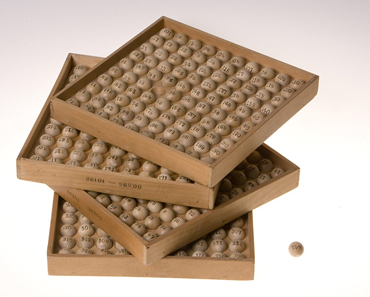
This content is available on the National Archives of Australia website:
Description
This is a colour image of the ballot balls that were used by the Australian Government as part of the National Service Scheme between 1965 and 1972. The four trays contain wooden marbles, each measuring approximately 1.5 cm in diameter, individually numbered from 1 to 366. Each marble represents a day of the year and the birthday of 20-year-old men who were potentially to be balloted into the Australian Regular Army (ARA).
Educational value
- These wooden balls were used to decide which men would be required to undertake two years of compulsory service in the ARA as part of the National Service Scheme between 1965 and 1972. In a process that was similar to a lottery, the balls were chosen randomly with the number on each ball representing a birth date. If the number picked corresponded, for example, to 5 February, all men who turned 20 on that date of that year were required by law to present themselves for national service.
- The balls (also known as marbles) were part of the operation of a scheme of selective conscription known as national service. The scheme was introduced by the Menzies government under the National Service Act in November 1964, and was designed to create an army of 40,000 full-time soldiers. The government believed Australia's strategic position had deteriorated and that it had inadequate defence personnel to deal with communism in Asia.
- Two birthday draws a year were held to determine who would be called up. The marbles were placed in a barrel and a predetermined number were drawn individually and randomly by hand. Marbles representing the days in the year from 1 January to 30 June were placed in the first ballot, and marbles representing the days from 1 July to 31 December were placed in the second. Within a month all those affected by the ballot knew if their birthdays had been 'balloted in' or 'balloted out'.
- Almost all Australian males were required by law to register with the Department of Labour and National Service in January if their birthday was in the first half of the year, and in July if their birthday was in the second half of the year. Indigenous Australians were not required to register. If balloted in and not granted an exemption, the men were required to perform two years continuous full-time service in the ARA or, after 1971, 18 months full-time or three years part-time.
- Just over one-quarter of the men balloted in were called up. Indefinite deferment was granted to men married before call-up, and to those with a serious criminal history. Temporary deferments were available on the grounds of hardship or compassion, and to students, apprentices and trainees at university, teaching or technical colleges. Exemption based on physical or mental disability, occupation and conscience was considered after the ballot.
- This method of selection was widely regarded as inherently unfair and strengthened opposition to conscription, which escalated as the government announced that troops were being withdrawn from Vietnam. Early opponents included the federal opposition, religious groups, trade unionists, academics and men affected by the scheme. Coordinated mass protests, known as moratorium marches, were conducted across Australia throughout 1970 and 1971.
